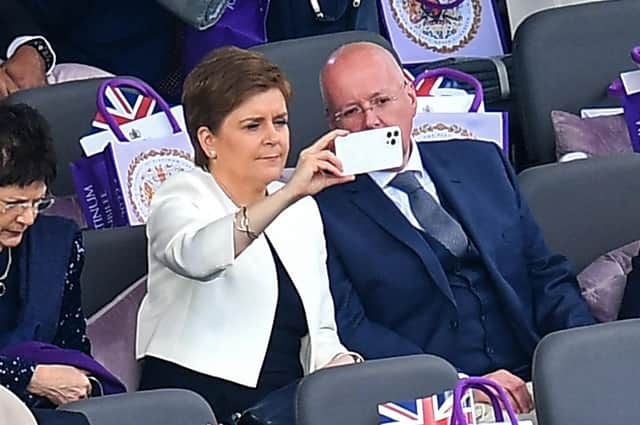Why Nicola Sturgeon sitting in the Royal Box at the Party at the Palace jars with me - Brian Monteith


Just a few weeks back there was much media interest in stepping back for just a moment to consider Nicola Sturgeon becoming, after seven years six months and five days, the longest serving Scottish First Minister and asking what she had or had not achieved. Despite the likelihood she shall be in office until at least 2025, unless she chooses to hand the reins over to a replacement in ample time for that year’s Holyrood elections, the poor nature of the “Sturgeon legacy” was, if only fleetingly, a topic.
Now we have just spent a long holiday weekend free to celebrate the seventy-year reign of the Queen – or instead play a round or two of golf or watch a box-set drama to avoid the cacophony of heartfelt tributes pouring in from the many events relayed to us by broadcasters. The comparison of service of one young girl who was not expected to be Queen staying the course for over seventy years and the youngest Scottish General election candidate of 1992, then elected to Holyrood in 1999 suggests to me that, for Britain at least, there is much to be gained from separating out partisan politics from choosing our head of state.
Advertisement
Hide AdAdvertisement
Hide AdOn becoming twenty-one the young Elizabeth dedicated her life to public service in a speech everyone should read and should be taught in schools as an example of selfless sacrifice to public duty. Her Majesty has subsequently shown up not just the many here-today-gone-tomorrow politicians passing her by – some fourteen prime ministers and still counting – but many world heads of state, be they other monarchs or presidents arriving through popular mandate or at the barrel of a gun.
What I found most remarkable about the last few days was the common thread of what was being appreciated publicly through loving testimony from those often in competition or conflict with each other – from young and old, the faithful and faithless, our political elite and the commoners who are apt to see through them – it was the continuity she has provided from her stoic, reserved and modest dependability, while others with great responsibility have vacillated, purposefully divided us and heightened emotional distress.
The planned and impromptu street parties with their Coronation chicken sandwiches, bunting galore and pots of tea; the reminiscing from Sir Cliff Richard, Lulu and the BBC back-catalogue of luvvies down the ages; the swelling crowds from all backgrounds and all communities across our islands; and the endorsement at the Jubilee party and Sunday’s pageant of being British as a unifying spirit from people of all races and all origins – gladly and willingly wrapping themselves in the Union Flag as their patriotic shroud – has been a testimony to the Queen’s triumph and legacy.
That so many people of such divergent views and diverse backgrounds wanted to say a loud and often soulful thank you is beyond the usual experience of our once taciturn, stiff-upper-lip character.
The positivity from a shared patriotism provided a stark contrast to the fear and division, if not barbarity, that is now being displayed as a result of nationalism where it takes grip in the rest of Europe.
Yet there among it all was our First Minster; admittedly an open and public admirer of the Queen’s exceptional individual character, and yet someone who wants to destroy the very harmony of our country. I could understand attending the thanksgiving service at St Paul’s on an official level as First Minister, just as when Free Presbyterian Lord Mackay of Clashfern attended the Catholic funeral mass of Lord Wheatley out of respect for his colleague in the judiciary. What jarred with me, and no doubt with many was to see Nicola Sturgeon and her husband, the Chief Executive of the SNP, sit in the Royal Box at the Platinum Party on the Mall clapping along to Rod Stewart, swaying back and forth with the rest of the British establishment, as artist after artist, including Diversity and Doc Brown, extolled the unifying power of multicultural Britishness.
It did not sit well with the same Nicola Sturgeon whose administration 400 miles up the road had restricted the distribution of the commemorative book about the reign of Elizabeth to primary school children in Scotland. The same children who will see education spending cut back in real terms as their First Minister abandons a commitment to closing the education attainment gap between rich and poor while opening faux embassies around her globetrotting globe. The same First Minister who has stopped recording literacy or numeracy but is happy to collect data about the sexual practices of school pupils or allow them to change gender without parental consent.
A First Minister whose legacy will be the educational debasement of a whole generation of Scots sees no hypocrisy in partying with those she works to separate us from. Did she go on to the after party too? Thank goodness for constitutional monarchy as embodied by the Queen, it provides an antidote for the narcissism of our modern-day hypocritical politicians
Advertisement
Hide AdAdvertisement
Hide AdWhen last week one broadcaster discussed the Sturgeon legacy thus far there really was not a great deal to cheer about. A claim the Baby-Box would be remembered fell below even the low bar of the Belisha Beacon introduced by Transport Minister Leslie Hoare-Belisha in 1934 to mark pedestrian crossings. The flashing amber lights, augmented later by Zebra stripes, are still with us eighty-eight years later, I rather doubt state-supplied cardboard boxes will last the course as long.
Brian Monteith is a former member of the Scottish and European Parliaments and is editor of ThinkScotland.org
Comments
Want to join the conversation? Please or to comment on this article.
